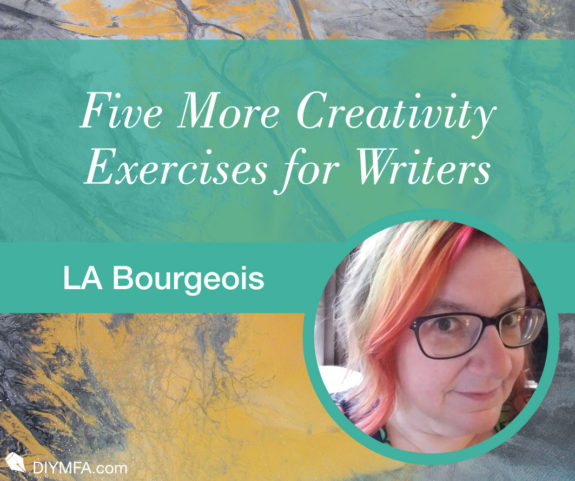Inspiration and imagination fuel every story we write. The events and characters flow through our minds and fingers with ease on the best days.
On the days when your idea pipe clogs, here are some creativity exercises for writers to pop your brain and get the stories flowing again!
Add a Goblin
Goblins are little agents of chaos. These weird-looking creatures exude a scary/cute vibe, moving with a sketchy abandon. Favorite pastimes include breaking important objects, losing essential items, and screaming nonsense at random passers-by. This character embraces the ideal of being a danger to himself and others.
And that’s just what you need for your stalled storyline. Splashing pandemonium across your writing pushes your imagination in a novel way.
Make a copy of the scene to be goblin-ified. Never work with the original. This exercise breaks the scene as it opens your mind. While you might want to incorporate ideas from this exercise, you’ll probably not want to make these changes permanent. Making a copy allows you some peace of mind as you loose your goblin amongst the good(ish?) people of your tale.
Now, add your goblin to the mix. You might choose to incorporate a real goblin, a paranormal creature menacing the charming town you’ve created. Maybe your goblin is in the head of your main character, encouraging her to sleep with her sister’s husband or give an imperious speech about the values of temperance. An invisible goblin might scamper around the room, hiding keys and leaving shoes on the floor for the characters to trip over, turning the entire dramatic scene into a slapstick farce.
Let your goblin run free!
When your goblin has absolutely destroyed everything, wait a day and then read through what you’ve written. See what new values and traits your characters revealed when thrown into this chaos. Pluck interesting changes out of the wreckage. Salvage the ideas that work and send the rest to the junkyard.
Image Play
A provocative image can push you to new heights of imagination. Find an image that you like and begin asking questions about it. If there’s a person in the frame, what are they thinking? What are they doing? How do they feel about what they are doing?
Looking at a landscape? Take the scene that’s giving you trouble and plop it into the middle of this space. How does it change the characters? Do they react differently? What new events unfold?
Or maybe you just need to work on your descriptive skills. Pull up an image and describe it, using the most flowery or sparse language possible. Use similes, metaphors, adjectives and adverbs with abandon.
A couple of my favorite places to find images are Museo and the Rijksmuseum.
Your Story Garden
Sometimes we need help with the whole story. If this is the case, try reimagining the tale as a garden. When you imagine your novel as a garden, what does it look like? Draw out your garden plan without thinking too much about it.
What season are you experiencing?
Is the landscape full of meandering paths? Maybe it’s a strictly formal garden, flowers regimented in rows. Or do you see something more like a corn maze?
What buildings are in your garden? How about water? What plants are growing? Any garden furniture? Does wildlife make a home in your garden?
Whether the images seem to go together or not, allow them to nestle into your landscape plan. This garden is imaginary, so everything is invited!
When you are done sketching the bones, pull out your colored pencils, markers, crayons, and paints! Add some color to your sketch and bring the image to life.
After you have completed the piece, set it aside for a day. When you return to it, what do you notice? What do each of the choices you made say about your work? Is there meaning hiding under the lilies? Does clarity fill the central fountain?
The Curiosity Card Catalog
Way back when rocks were soft and dinosaurs roamed the earth, we used a card catalog to keep track of all of the books in the library.
In your Curiosity Card Catalog, we delve into your local library’s stacks randomly and see what pops out!
Grab some dice (bonus if you have ten-sided ones) and head to your local library.
The nonfiction section of the library is organized according to the Dewey Decimal system. Within this section, a series of three numbers are used on the side of each book. These numbers range from 000 to 999.
We’re going to randomly select three numbers using the dice.
Since you need numbers between one and ten, use whatever combination of dice you need. A single ten-sided die will serve you well in this situation, as the 10 can serve as a zero.
At the library, throw your dice to select your three numbers.
Whatever number comes up, head into the nonfiction section and find the appropriate selection of books. Grab the first one that sparks any sort of interest.
Repeat the whole exercise at least two more times.
Take your three books and skim them, either at home or in the library. Dip in further when something catches your eye. Indulge your curiosity by doing further research.
Someone Else’s Life
While in a busy environment, say the gate at the airport or a crowded beach, select a person and watch them. Get curious, but don’t stalk them.
Maybe stalk them just a teeny tiny bit.
Ask questions as you observe. Why are they lingering on that particular park bench? Who are they rushing toward as they zip through the terminal? What prompted her to wear a thong bikini with a sparkly gold net cover up to Trader Joe’s?
Let their look, actions, and belongings build a persona in your head. Select an origin and a destination for their trip. Imagine their home. What’s their job?
Build a full life for them. Add all of the details you can. Tell the story of the woman in the bikini making a dinner of frozen fried rice and Barolo for her lover, of the fellow standing at the door of his childhood home and trying to decide if he should knock or just walk inside, of the person lying on the beach in Bora-Bora with an arm outstretched to brush the skin of their life partner.
Once the character is in your head, take a moment to write their story in your journal.
And Finally…
If you need more inspiration, click over to my very first post for DIYMFA which included five completely different creativity exercises to pop your brain.
This is my last regular post for DIYMFA and I want to say what an honor it’s been to encourage you in your creative goals! Keep writing, my friends. I can’t wait to read your stories.

LA (as in tra-la-la) Bourgeois is a certified Kaizen-Muse Creativity Coach who empowers you to embrace JOY as you manifest your creative goals through her Creativity and Business Coaching. Battle resistance, procrastination, and overwhelm with her at your side, gently encouraging with humor and heart. Discover more at her website, labourgeois.biz.







